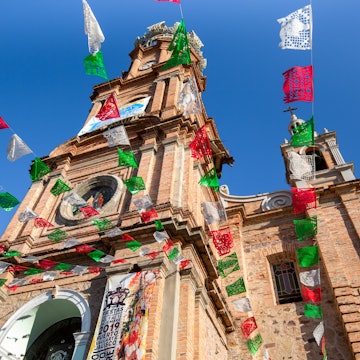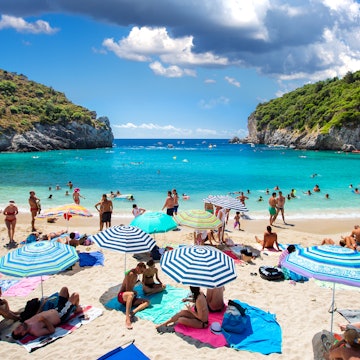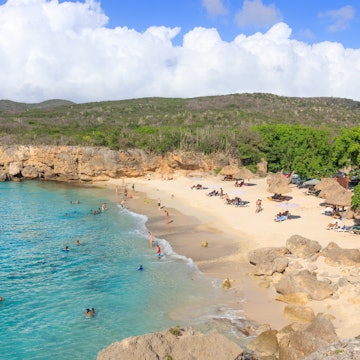

There are many incredible walks to do in Spain's Andalucía from day walks with children to multi-day hikes © Jeremy Woodhouse / Getty Images
Andalucía, the south of Spain, is celebrated for many things: its Moorish heritage, its sun-kissed beaches, its warm, festive people… but it’s also a tantalizing natural smorgasbord of high mountains, green valleys, surprisingly untamed coastlines and often-visible wildlife – a true delight for anyone who loves getting out into nature on foot.
Almost one-third of Andalucian territory is environmentally protected in national parks, natural parks and other areas. Many of these boast clear trail networks and good infrastructure for walkers. The greatest concentration of top routes is in the Sierra Nevada mountains south of Granada (containing three of Spain’s six highest peaks) and the picturesque Alpujarras valleys on their southern flank. But many other great trails are scattered throughout Andalucía’s eight provinces.

1. Acequias del Poqueira
Best introduction to the Sierra Nevada
17km (10.6 miles) round trip, 7 hours, difficult
This superb walk leads you up one of the most dramatic Alpujarras valleys, the Barranco del Poqueira (Poqueira Gorge), then returns by a wonderfully panoramic high-level path. There are good chances of sighting ibex (wild mountain goats) en route. With 870m of ascent, the route requires reasonable physical fitness.
Your path (the PRA23) begins near the top of pretty Capileira village. The Sierra Nevada’s two highest peaks, Mulhacén (3479m) and Veleta (3398m), soon come into view. Passing through the abandoned village La Cebadilla, with its small hydroelectric station, you zigzag up the valley side then cross mountain pastures before descending to the Río Naute mountain stream.
Now begins the hardest stretch, climbing to the Cortijo de las Tomas, a remote upland farmstead at 2120m. Reward yourself with a picnic stop on its grassy surrounds. Your return route weaves its way across open hillsides high on the east side of the valley, revealing fabulous panoramas of Sierra Nevada peaks.
Three kilometers from the cortijo you meet the Acequia Alta de Pitres, one of the centuries-old network of irrigation channels (acequias) that give the walk its name. Descending, you cross the Acequia Baja (Lower Acequia) before passing through pine woods and back into Capileira.
If you’d prefer a shorter outing from Capileira that still gives a good taste of the Barranco del Poqueira, go for the PRA69, a 7.5km (4.7 miles) loop.
2. Río Borosa
Most beautiful walk
22km (14 miles) round trip, 6 hours, moderate
The rugged Parque Natural Sierras de Cazorla, Segura y Las Villas in northeast Andalucía is crisscrossed by many scenic trails. Its Río Borosa route is one of the most beautiful walks in Spain, following a crystal-clear river through scenery that progresses from the pretty to the majestic. It’s a fun one to do with (willing) children. Start at a parking area 1.5km east of Torre del Vinagre visitor center. The easily-followed, well shaded trail initially runs beside the tumbling, turquoise Río Borosa. After 3km you diverge through the narrow Cerrada de Elías canyon, where the path takes you to a boardwalk above the rushing river.
Rejoining the dirt road after 1.5km, continue 3km to a small hydroelectric station. From here a footpath climbs 3km beneath rocky crags and towering cliffs, passing a series of impressive waterfalls (thunderingly spectacular after rain, but sometimes disappointingly dry), to two dark tunnels. It takes about five minutes to walk through the first tunnel, and about one minute for the second, by narrow paths beside the watercourse. You emerge just below the Embalse de los Órganos reservoir, amid forested hills. Walk five minutes left from the dam to the Nacimiento de Aguas Negras, where the infant Borosa wells out from under a rock – a perfect picnic spot before you head back down.
3. La Tahá
Best for a sense of history
16km (10 miles) round trip, 6 hours, moderate
Feel the vibes of Andalucía’s Moorish past as you walk through charming Alpujarras villages and up and down superbly engineered old paths known as escarihuelas negotiating the plunging flanks of the Río Trevélez valley. The name Tahá refers to a group of seven villages here. Our route starts in Pórtugos and winds down footpaths and tracks among fruit and nut orchards through little Atalbéitar, Ferreirola and Fondales, with their flat-roofed Imazighen (Berber)-style houses. Cross the Puente Romano (‘Roman Bridge’ but more likely Moorish) over the ravine below Fondales and follow the Escarihuela de Fondales for 2.5km up on to the south side of the valley, where you then walk 4km east enjoying ever better views of the Tahá villages. Turn sharp left at a small group of houses, the Cortijo de Panjuila, to descend the Escarihuela de Panjuila and cross back over the ravine by a bridge beside a ruined watermill. Take the westward path to Ferreirola then head back up through Atalbéitar to Pórtugos.

4. Las Negras to Agua Amarga
Best coastal walk
13km (8 miles) one-way, 4 hours, moderate
The Cabo de Gata peninsula at Spain’s southeast corner is a desert-like, volcanic landscape fringed by cliffs and capes of otherworldly grandeur washed by azure Mediterranean waters – a low-key haven for an eclectic assortment of visitors and residents. The walk along the remote coast between Las Negras and Agua Amarga villages combines landscape drama with little-visited beaches and a curious "hippy" village.
Follow Calle Aguillas north from Las Negras’ main street for 750m then turn right following a "Cala de San Pedro" sign along a dirt road. Enjoy expansive views over Las Negras bay en route to a parking area after 2.25km. From here your path winds high above the sea to San Pedro village on a deep blue bay between cliffs and a ruined castle. Long abandoned by its original inhabitants, San Pedro now houses an alternative-lifestyle community living in rehabilitated ruins, tents and caves. A couple of rustic, erratically-open beach bars sell drinks and snacks.
The path to Agua Amarga climbs steeply out of San Pedro before leveling off along the top of an inland cliff. Take care! You descend to the sandy beach at Cala del Plomo, then wind round behind a small hill, Cerro de la Higuera. At a track junction 1.2km from Cala del Plomo you can divert down to Cala de Enmedio beach, or continue ahead on a rocky uphill path. Wind across another small hill, Cerro del Cuartel, and finally down into Agua Amarga with its 500m sandy beach and plenty of lodgings, cafes and bars to kick back in. If you want to return to Las Negras, a taxi costs 40€ to 50€.
5. Mulhacén
Best for peak baggers
11km (7 miles) round trip, 4½ hours, difficult
Perhaps surprisingly, the highest mountain in mainland Spain – Mulhacén (3479m, 11,414ft) in the Sierra Nevada – can be summited by any reasonably fit walker in a day trip. Thanks to a national park minibus service from the Alpujarras village of Capileira, this crowning achievement only requires walking about 5km up and 5km down, albeit with nearly 800m of ascent and descent. Unusually for Andalucía, this walk’s best season is summer, ideally July to mid-September. But note that summit temperatures are regularly 10°C to 15°C cooler than in Capileira, and weather can change surprisingly quickly.
The minibus, officially the Servicio de Interpretación de Altas Cumbres, operates from approximately June to November. For information and reservations (advisable) email siacsur@gmail.com or call +34 671 564406 (English spoken). The minibus drops you near a point called El Chorrillo at about 2700m, from where the trail climbs steadily up the Loma de Mulhacén ridge to the secondary peak Mulhacén II (3362m). The final, less steep 1km to the main peak is across an impressively desolate wilderness of gray rock. The views from the summit are infinite, but take care: it stands right on the edge of a 600m precipice.
To vary the route back, turn down a narrow but clear path to the right, just 80m back from the summit. This zigzags down Mulhacén’s steep western flank to meet the Sierra Nevada Road, a former motor road across the range (now barely recognizable as such). Walk left along this to return to El Chorrillo.
6. Garganta Verde
Best for spying birds of prey
5km (3 miles) round trip, 2½ hours, moderate
The Sierra de Grazalema in Cádiz province, where Atlantic winds first hit Andalucian hills, is the wettest place in Spain. Over the millennia the abundant water has carved the limestone rock into many dramatic formations - none more so than the 200m-deep Garganta Verde (Green Gorge).
What makes the descent into this lushly vegetated nether world (and the steep climb back up) especially exciting is the large colony of griffon vultures nesting on the canyon walls. These enormous birds - with wingspans up to 2.5 meters – frequently cruise around the canyon’s upper reaches and you may hear the wind ruffling their feathers as they whoosh by.
The trail is closed because of fire risk from 1 June to 15 October. When it’s open, you need to make a (free) advance reservation as there are daily limits on the number of people allowed. This can be done via the regional environment ministry, but the website is in Spanish and not exactly intuitive. Using an experienced local activities firm such as Horizon can simplify and speed up the process.

7. Caminito del Rey
Best canyon walk
7.7km (4.8 miles) one-way, 2½ hours, easy
A series of boardwalks fixed high up the sheer walls of the Río Guadalhorce’s spectacular canyon have made the "King’s Path" probably Andalucía’s most famous walk. The boardwalks comprise just 1.5km of the route, but the scenery is awe-inspiring all the way: in places the canyon rises to heights of 700m and its walls narrow to just 10m apart. The Caminito is 60km northwest of Málaga and was originally a maintenance track for water channels feeding a hydroelectric station. It owes its name to Alfonso XIII, who walked it in 1921. It was fully renovated in 2014 to 2015 and is very popular: you need a ticket (unguided/guided €10/18), and should reserve a spot well ahead of your visit. Obligatory hard hats are provided! The walk route is one-way only, north to south, and ends at El Chorro-Caminito del Rey train station (with several daily trains to/from Málaga); the end and start are connected by a shuttle bus. Parking is available at both ends and at a visitor center on the bus route. Allow four hours for the full circuit including the bus. This is not a strenuous walk, but vertigo sufferers might prefer to avoid it. Children under eight are not allowed.
8. GR7
Best long-distance walk
700 to 750km (435 to 466 miles) one-way, 6 to 7 weeks, difficult
The GR7 traverses the length of Spain, from Tarifa in southwest Andalucía to the border with Andorra in the north. Its 700km-plus course across Andalucía takes in many of the region’s most scenic areas and handsome historic towns like Ronda and Antequera. The route divides 18km past Antequera at Villanueva del Cauche: one branch heads east to Las Alpujarras then north across the Sierra Nevada, while the other goes northeast crossing the mountains of Córdoba and Jaén provinces. The two meet at Puebla de Don Fadrique shortly before leaving Andalucía to enter Murcia region.
Few people walk the full 700km-plus in one long haul. Particularly attractive stretches of a few days include Lanjarón to Laroles in Las Alpujarras, and Cazorla to Santiago de la Espada through the Cazorla mountains. Trail maintenance and signage is reasonable though you’ll need navigational skills at times. There’s plenty of detail (in Spanish) from the Federación Andaluza de Montañismo.
Top tips for walking in Andalucía
The best months for walking in most areas are April, May, June, September and October.
Carry a decent trail map or GPS device; sometimes you’ll need to check your route or navigate yourself.
Take plenty of water and be equipped for changes in the weather, especially in the mountains.
Day-walk times in this article are approximate actual walking times; they don’t include stops for refreshments, rest or photos.
For more detail on many of the walks featured here, get yourself a copy of Lonely Planet’s Best Day Walks Spain.
















